Our tour today will start at Angkor Wat, then to Ta Prohm, and Banteay Srei.
Angkor Wat
 |
| East gate |
There is only one thing I can say about Angkor Wat : Grand. We spent 2,5 hours there and we just felt it was not enough.
This magnificent temple was built in the early 12th century by king Suryavarman II who was a Hindu so it is a Hindu temple. Angkor Wat was built symbolizing the center of the Hindu universe : Mount Meru, a place where the gods live.
We enter the temple from the East gate, it was much more private, besides us there was only 3 other tourist around, the gate was pretty to take pictures, though the condition is not as in mint condition as the West (main) gate, but it was beautiful in it's own way.
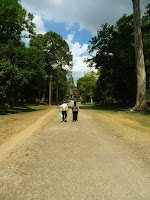
 |
| Path from East gate to the temple |
After passing the gate we go through a path with high but not dense trees. Entering the temple from this gate since it is less crowded and has more trees, it takes lesser time to reach so we felt it was a nearer path comparing the main gate, but the true distance we don't really know.
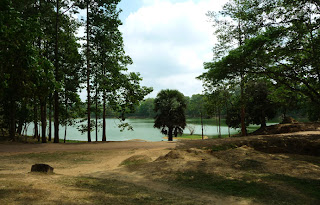 |
| Man made moat at East gate |
The temple is surrounded by the man made moat, giving a feeling that Angkor Wat is temple on an island. If we go through the main (west) gate it will take around 1 km from the bridge to the temple. At the period where Angkor was abandoned due to the war, resulting all of the temples are surrounded even occupied by large trees but only Angkor Wat is never truly abandoned as it was still taken care of by the Buddhist monks. This is why even though originally Angkor Wat is a Hindu temple, nowadays it is used by Buddhist.
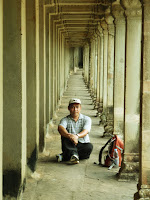
 |
1st level - pillars nearby bas-relief mostly has carvings of a hermit (one of the
avatar of Shiva) on the below part to protect the temple, it is believed
that under the pillar has a gold coin to protect, it is said that it's still practiced by the traditional Cambodian |
Once on the terrace of the temple, we can see that the temple is enclosed with the body of the naga, symbolizing that the naga or the odd number headed serpent is protecting the place, we find this in some other temples as well.
The temple has 3 levels, the 1st level has the most bas-relief carving, each wall is telling each stories, including the famous "Churning of the ocean of Milk" which on the process created the Apsaras (the beautiful dancers and musicians of the gods), it is said that in Angkor Wat there are more than 3,000 bas-relief of the Apsara.
 |
| Rope to protect the bas-relief |
 |
| Bas-relief in the middle is shiny due to frequent touch of human hands |
You can see that some part of the bas-relief are a bit shiny this is due to the touch of many people on it (and to protect it from happening again, in front of the reliefs around 50 cm in front is now restricted using rope) and on some of the reliefs has colors on it, some says that originally it was just ordinary stone bas-relief then it was coated by the Buddhist monks but another theory is also saying that at the time it was built, the bas-reliefs are coated in gold. Before enjoying it you can read the explanation on the small info board so you can have an idea of what story the bas-relief was telling. Since we started our 1st level from the bas-relief of "Churning of the ocean of Milk" and going to the right, we finished our 1st level at the story of Rama & Shinta or the battle of Lanka, which means we missed 3 walls to explore on this floor.
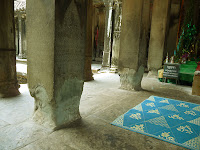
 |
| Hall of a thousand Buddhas |
To enter the 2nd level we have to enter the hall of a thousand gods (Buddhas) but most of the statues are gone already,
statues that are not being used as a shrine here are located in the National Museum. There are 4 pools there that symbolizing the nature's 4 elements : earth, water, air and fire which all are in the human body. But now the ponds are not filled with water anymore.
 |
| Diary of the monk |
 |
| Grafiti |
There are some pillars in this hall that were carved written on in Pali by the monks in the olden days on how they had lived etc such as a diary, but on some of the pillars as well sadly there are new graffiti carving of tourist names. There are some walls here that were all carved in Apsaras, it is said to bring good luck to touch their breast. On the left side of the Buddha shrine there are some other Buddha's statue but sadly most of the head had been chopped (sold by illegal dealers), some of them has a new head so we can try to imagine how it would look like originally, passing these statues we can go up the stairs to the second level.
 |
| Apsara |
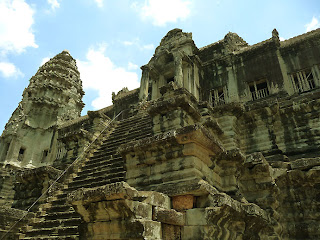 |
| 2nd level view of the 3rd level |
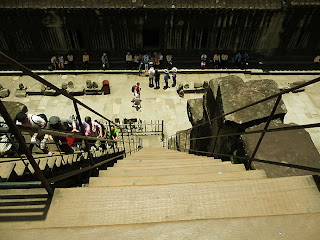 |
| Modern stairs to the 3rd level |
On the 2nd level we are greeted with a terrace with main view of the main temple, there are little buildings as well on the terrace, said to be the library, but mostly it has no more roof. If you are here at noon just like us, make sure to bring hat or umbrella to cover yourself from the sun. From here we can see that they have built a new wooden ladder with metal railings to maintain the old staircase from being used and for safety sake as well, as the steepness I would say it is almost the same but the original steps are much more smaller than the new ones. The steps are 11 meters high but since it is quite steep just be careful and hold on the railings.
 |
| Pool and tower at 3rd level |
 |
| 3rd level towers - a large beehive on the tower |
On the 3rd level, you can see the view around of the temple surroundings, most of it is the jungle. In the 3rd level itself there are 4 square terraces which I think used to be pool as well. We can walk in circle of the 3rd level to the 4 cardinal points (towers).
.jpg) |
| Buddha Shrine - standing and reclining |
In the middle of these 4 pools is a Buddha statues shrine (standing and sleeping), which at the original supposed to be a Vishnu shrine and open on each side, but the monks closed the Vishnu shrine with walls and feature the wall with the Buddha statues instead. Our guide said that the Vishnu statue was brought outside of the temple in front, but at the time we exit the temple I forgot to ask where the statue was :P
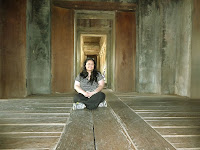 |
| Chamber inside one of the 3rd level tower |
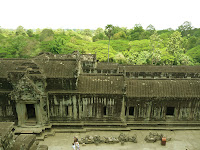 |
| Surrounding view from the 3rd level |
After finished exploring the 3rd level, time to go down, and exit the temple from the main gate, it was beautiful, especially around the bridge on the moat area and seeing the temple on the background you can see how grand Angkor Wat is.
 |
| Stone path between West gate and temple of Angkor Wat |
We surely will go back tomorrow to explore it more. Now is time for our lunch, our guide brought us to the nearby restaurant (I guess it was in front of Angkor Wat itself), the food is quite ok but we preferred the food downtown better we ordered sweet and sour pork (the pork slice is tender, but it is not deep fried with flour first as we use to have at chinese restaurants) and eggplant with minced pork, we forgot how much each food cost but it was a bit more than what we paid at downtown, and the white rice is not free as our previous restaurants, If I was not wrong, it all cost around USD 20 for both of us.
Finished with our meal, we are ready for our trip to Ta Prohm, and Banteay Srei.










.jpg)


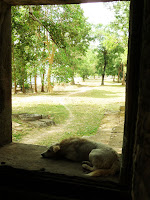

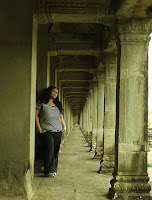














No comments:
Post a Comment